Elahe Izadi / DCentric permalink
Michelle Jones, owner of A.S.P.I.R.E. health store at 7th and H streets NE.
Urban affairs, neighborhoods, subways and the people who are affected by them all.
Michelle Jones, owner of A.S.P.I.R.E. health store at 7th and H streets NE.
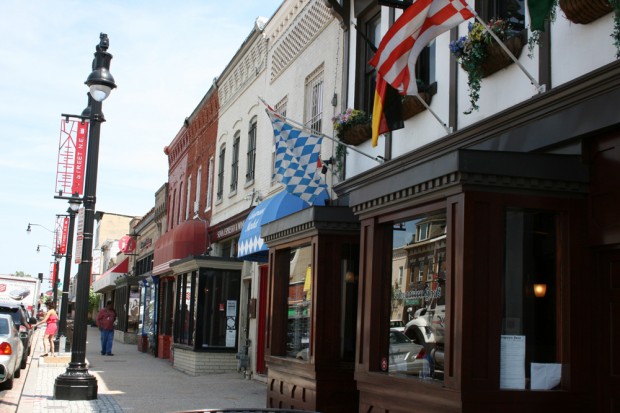
A number of new businesses have populated formerly vacant storefronts along the upper end of H Street. But they're mostly restaurants and bars.
Much has been made of the changes along H Street NE as the corridor continues its transformation from a primarily low and middle income black community to one that is wealthier and whiter. Trendy bars and restaurants are increasingly opening in vacant storefronts, attracting diverse patrons en masse during late night hours. But the crowds are nowhere to be seen during the day.
A new D.C. grant program is intended to draw more retail options to the street, creating an H Street that’s as bustling during the day as during the evening. That’s welcome news for many existing business owners who want more people on the streets and in their shops.
“You just don’t want it to be all bars and restaurants,” said Anna Collins, co-owner of pet store Metro Mutts at 5th and H streets.
Continue reading
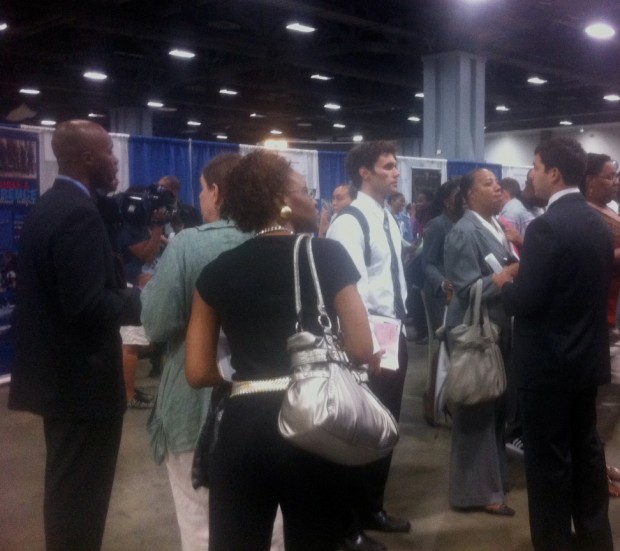
About 4,100 unemployed and underemployed District residents came to Tuesday's job fair.
An annual D.C. employment fair drew one of its biggest crowds Tuesday as the District faces an unemployment rate that is higher than the national average.
“This turnout breaks my heart,” said Del. Eleanor Holmes Norton, who hosted the 14th annual fair. “This is a record I wasn’t out to break.”
Last year, about 3,500 people attended Norton’s fair. This year, nearly 4,100 District residents came. About 500 people waited for doors to open at 11 a.m. By noon, a large line of job seekers weaved throughout the Convention Center, from the entrance, down escalators and wrapped around long hallways.
Unemployment in the District is uneven; jobless rates are higher than 20 percent in predominately black and low-income Ward 8, while it’s slight above 3 percent in affluent Ward 3 [PDF].
“The disparity has to be gotten rid of in the District,” Norton said. “The only good jobs available in the government or private sector are upscale jobs. If you don’t have at least a year or two of college, you’re doomed.”
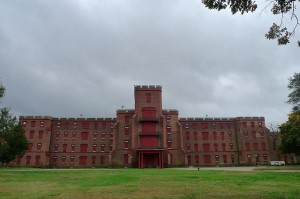
John / Flickr
The west campus of St. Elizabeths in Southeast D.C. will be the site of the new U.S. Coast Guard headquarters.
Neighborhoods east of the Anacostia River are undergoing changes, albeit they aren’t taking place as rapidly as west of the river.
Higher-income folks slowly moving into east of the river communities, which are primarily low-income, are contributing to those changes. But massive development projects will likely have more of an immediate, and major, impact on the area.
Much of that development will take awhile; the transformation of St. Elizabeths Campus into the new U.S. Coast Guard headquarters likely won’t be complete until after 2016. But other projects, meant to piggy-back off of the St. Elizabeths project, may come to the neighborhood before then. The Washington Post reports that plans are being finalized for the $25 million redevelopment of 2235 Shannon Place SE from a police evidence warehouse into a mixed-use office building:
The office project is the first step in a long-term, transformational overhaul of downtown Anacostia being planned by a partnership between District-based Curtis Properties — which owns large chunks of land there — and Four Points, a D.C. developer that is making its name on projects in emerging neighborhoods.
Such projects will bring many daytime office workers east of the river, people who want options for lunch and who may want to relocate to nearby neighborhoods to be close to work. Some are already bracing for the changes. The District’s Department of Transportation has plans to expand D.C. Circulator to roll past St. Elizabeths Campus in the next few years.
Last week, while in an elevator, a well-dressed, slightly-older woman looked at me intently and said, “You have interesting skin,” before asking its origin.
I have dark skin, black hair and large brown eyes.
Despite the fact that this issue has been written about over and over and over again, people still don’t get that asking “Where are you from?” is problematic on many levels. The question may come from a good place, but it often puts the recipient in a bad one. It’s also worth considering who gets asked about their origins and who doesn’t. If you don’t ask everyone where they are “from”, why not? Why is the question frequently aimed at people who have darker skin, immigrant parents and yes, interesting backgrounds, if not to emphasize difference?
Here are some ways to ask someone about their heritage without sounding boorish or entitled:
Use a compliment. Sports Illustrated model Chrissie Teigen is asked about her Norwegian-Thai ancestry daily and doesn’t mind, but she had this advice for the curious: “I usually go with ‘What’s your background, you are beautiful”.
Be direct about what you are asking. On DCentric’s Facebook page, reader Laurie Peverill volunteered that she asks strangers about their “family history”, instead of the nebulous “Where are you from?” She adds, “Assuming that very few of us are actually from here originally, everyone has a great answer.”
Ask other questions first. DCentric reader Jasmin Thana also used Facebook to convey how she is dismayed that “Where are you from?” is often the first question strangers ask her. “Know my name first. Have a conversation with me, then you can ask where my ancestors are from. The question annoys me because they’re trying to put me in a box and if people just guess correctly, the look on their face is like they just won a prize.”
In a DCentric post from April, my colleague Elahe wrote, “All of this isn’t to say that I, or other second-generation Americans, aren’t also proud of our heritage and roots.” But the hope is that one day, people will be content to see the children of immigrants as peers, and not ethnic riddles to be solved.
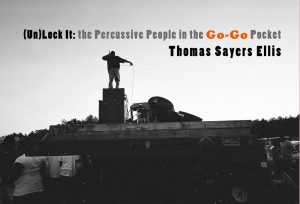 What: “(Un)Lock It: The Percussive People in the Go-Go Pocket” photo exhibition.
What: “(Un)Lock It: The Percussive People in the Go-Go Pocket” photo exhibition.
When: Opening is from 6 to 8 p.m., Friday. The show runs until Oct. 7.
Where: The Gallery at Vivid Solutions, 2208 Martin Luther King Jr. Ave SE.
Cost: Free.
Why you should go: Photographer and drummer Thomas Sayers Ellis has been documenting the lives of local go-go stars and shows since the 1980s. His images capture D.C.’s homegrown musical culture even as it appears to be vanishing from the District’s borders.
Other events to consider: If you’re between 13 and 17 years of age (or know someone who is) consider attending Portraits After 5, which will feature a youth fashion show, portrait booths and the chance to view art at the National Portrait Gallery. The teen event takes place 6 to 10 p.m., Saturday.
Racial disparities in drug enforcement are well-documented. Today, Washington City Paper‘s Rend Smith digs into how this plays out in the District, where black residents are eight times more likely to be arrested for marijuana possession than whites.
Smith writes about the common notion that white people tend to buy and smoke marijuana inside their homes, as opposed to African Americans who deal and smoke outside more frequently:
Court records for some of those arrested east of the river back that belief up. They describe vice officers spotting suspects engaging in open-air blazing or buying from street corner dealers. One subject “was walking down the street smoking a brown cigar” when cops spotted him. The recklessness involved would seem to disqualify disparate rates of marijuana arrests in the city as a civil rights issue: Black smokers are choosing to be flagrant about their pot use and so attracting the attention of cops who have no choice but to grab them.
But even if assumptions about smoking and dealing habits are solid, that doesn’t mean there’s no problem with the way marijuana laws are currently being enforced in black and white neighborhoods. Taking my own experience as an African American who grew up poor into account, I remember some family and friends who puffed outside—whether that involved a pack of Kools or a joint meticulously sculpted from Top rolling papers—out of respect for others in their household, particularly where there was more than one generation (and therefore more than one set of moral values) under one roof. Dealing inside the house would have been all the more inappropriate. Although that’s certainly not the situation for every black person who tokes up or does a hand-off in Ward 7 or Ward 8, the idea is that you can’t just assume they’re being belligerent, and therefore asking for repercussions.
The problem becomes even more pronounced in D.C., given the city’s high incarceration rate (fourth in the nation, when compared to states). Marijuana possession can land you six months in jail and up to $1,000 in fines.
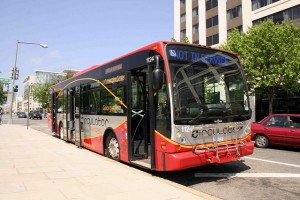
Elvert Barnes / Flickr
Riding D.C. Circulator can be much more pleasant than riding Metrobus; lower fares, more frequent buses and simple, quick routes. Starting Oct. 3, the buses will drive east of the Anacostia River for the first time.
The D.C. Department of Transportation began D.C. Circulator in 2005 as an easy way to get around areas that had a lot of activity. Most of the buses travel in Northwest. But the Circulator may end up serving other purposes as well in Ward 8, where 20 percent of people earn less than $10,000 a year and the unemployment rate is higher than 20 percent.
“You can live in the same city and there can be so many walls, real and perceived, for children, families and households who want to enjoy their D.C. experience,” ANC 8D06 Commissioner Kianna Fowlkes said during Tuesday’s DDOT public hearing. “Circulator is a really good way to extend over to this side and make us feel like we have access to the same sites, cultural or economic, to jobs, to the same food.”
Fares cost $1, which is 50 cents cheaper than Metrobus. The buses are more reliable, arriving every 10 minutes, and only make three or four stops a mile. The buses are proposed to start at Skyland and arrive at the Harris Teeter and the Potomac Avenue Metro.
D.C. Assistant Police Chief Diane Groomes says that the Metropolitan Police Department is facing “challenges” in and around Columbia Heights, where Latino immigrants are often the targets of a growing number of robberies and assaults:
The reason? “I think people realize they might be carrying cash, also they might not report it to police, so I think they become victims of crime more than others…they present a unique opportunity,.” Groomes said.
The area, which law enforcement call Police Service Area 302, is bordered by 16th Street NW, Harvard Street NW and Park Place NW, and it’s 31 percent Hispanic. Groomes characterized the incidents as crimes of opportunity, not hate crimes.
Didier Sinisterra, deputy director of the Mayor’s Office of Latino Affairs confirmed that the office is working with police to provide information to Latino residents on protecting themselves. .
“We have identified three key locations where we will be doing local outreach to inform people and hand out additional information: Spring Road, Mount Pleasant St and Columbia Heights.”
According to Sinisterra, the outreach efforts received a positive response. “We engage our community, go into local businesses. We let people know about the situation and we encourage them not to carry a lot of cash. We chose Friday because that is when a lot of Latinos get paid.”
OLA is also encouraging people to open bank accounts, so that they aren’t carrying large amounts of cash. This week, they will be in Mount Pleasant on Friday, from 4 p.m. to 7 p.m.
Josie Rizo, who works on the 1400 block of Irving St NW isn’t concerned. “So far nothing has happened and I’ve been working here for a year now,” she said, adding that she would go to the police if she is targeted by a crime. “I feel pretty safe…In this area especially, there are a lot of people walking around, so that helps.”
Housing in the D.C. suburbs costs a lot less than in the city, particularly with rising housing costs, but higher transportation costs could outweigh the savings.
That’s according to a new report [PDF] by the D.C. Office of Planning, which shows residents in dense neighborhoods such as Columbia Heights spend an average of $840 a month on transportation, whereas those living in suburbs in Montgomery County could spend $1,177 a month. DCist reports:
The numbers bear out what many people know from experience — higher residential density and more transit options make it cheaper for people to get around. Sure, you might be paying more for less space in that new house or condo, but alternatives further asunder may well spike your costs for getting to and from work.
Living in a smaller apartment or house in order to be closer to buses and Metro stations may not be feasible for everyone. Having less space isn’t as big an issue if you’re single or are living with one partner. But if you have three kids and a spouse, your quality of life could be significantly reduced by living in together in a small place. Perhaps the decision to move from D.C. and into the suburbs isn’t the best bottom-dollar choice for single folks. But some families may make the move because they can’t justify living in such cramped quarters so that one or two adults have cheaper and quicker commutes.
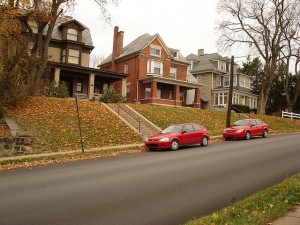
Cynthia Closkey / Flickr
A class divide doesn’t fully explain racial neighborhood segregation, a new Brown University study finds.
Nationally, affluent blacks and Hispanics live in poorer neighborhoods than where the average low-income white person lives.
The D.C. region bucks the trend somewhat; here, wealthy minorities live in areas with the same, not higher, poverty rates as where poor whites live. The proximity of Prince George’s County may skew the results for the region, the Washington Post reports. The county, which is 65 percent black, is home to high concentration of affluent African Americans:
Blacks and Hispanics… who earned more than $75,000 lived in neighborhoods that were virtually the same as neighborhoods populated by whites earning under $40,000, as measured by average income, poverty rates, education levels, home values and housing vacancies.
“Income, and being successful in class terms, does not necessarily put you in a different kind of neighborhood,” said John Logan, a Brown University sociologist who analyzed census data in his study released Tuesday.
Many in D.C. proper view class, not race, as the District’s biggest divider, but racial segregation is more prevelant in the city than in the region as a whole. And the wealthiest areas in D.C. also have the fewest numbers of African American residents. For example, the black population accounts for only 5 percent of Ward 3, the city’s wealthiest area, where the median income is about $97,000.
The NPR Argo Network is a collection of websites by NPR member stations committed to strengthening local journalism
Learn More...
Humanosphere reports on global health and the fight against poverty from KPLU in Seattle
The Empire Reports on city and state politics from WNYC in New York
The Informant reports on cops, courts and communities from KALW in Oakland
Multi-American reports on immigration and cultural fusion from KPCC in Southern California
On Campus reports on higher education from MPR in Minnesota
Ecotrope reports on nature and community from OPB in Oregon
The Key reports on local music from WXPN in Philadelphia
CommonHealth reports on health, medicine and healthcare reform from WBUR in Boston
Argo MindShift reports on technology and education from KQED in San Francisco
Home Post reports on the military from KPBS in San Diego